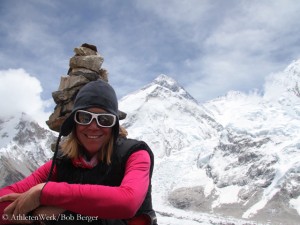Heidi Sand: “You have only one life. Use it!”
Impossibly Heidi Sand could have foreseen that Denali would change her life in this way. When the German mountaineer and sculptor descended from the summit of the highest mountain of North America (6,190 m) in 2010, the then 43-year-old suddenly had strong stomach pain. Soon after the shattering diagnosis: advanced colorectal cancer. After the emergency surgery, chemotherapy followed. “If I survive, I want to reward myself with an eight-thousander,” Heidi then promised herself – and fulfilled this dream of her life: On 26 May 2012 the mother of three children stood on the summit of Mount Everest.
Meanwhile Heidi Sand has passed the critical five-year mark after her cancer diagnosis. She is considered to be cured – and has realized further climbing projects after having summited Everest. In autumn 2013, for example, Heidi scaled Cho Oyu without using bottled oxygen and in spring 2014 she stood on top of Makalu (with breathing mask). With Billi Bierling, Heidi shares the honor of having been the first German women to reach the summit of Makalu. Sand dedicated her three successes on eight-thousanders to her children, for her husband remained the Eiger North Face which she succeeded to climb a year ago, in December 2015. And last November, she tackled, along with the Swiss mountain guide Lorenz Frutiger, the legendary granite giant Fitz Roy in Patagonia – in vain, the weather put a spoke in their wheel. I asked the 50-year-old four questions about her climbing.
Heidi, what do you owe to the mountains, especially Mount Everest?
It is simply an incredible feeling to be able to stand on the highest point on earth. Knowing that your mental strength and physical fitness have brought you up there. Every new summit gives me a new perspective – not just the surrounding area, but also particularly on myself, on my life. It gives me strength and confidence.
I set the goal of climbing Everest during the chemotherapy, and this goal drew me out of my valley. Do not sit down and fall into self-pity, get up! Move and find the light at the end of the tunnel!
As a cancer sufferer you cheated death. Has this experience made you more courageous or at least more willing to take risks in the mountains?
I am now focusing more on things that really matter to me, which are close to my heart. We owe it to ourselves and the others to make use of every day. You have only one life. Use it!
I am not more willing to take risks than before. But since I am now more often in the mountains and pursue my goals more consistently, I take, at large, higher risks, but it’s worth it.
After Everest you also climbed Cho Oyu and Makalu. That’s it? Or are you planning to scale other eight-thousanders?
I had a score to settle with Cho Oyu and in addition wanted to climb an eight-thousander without bottled oxygen. Makalu is climbed far more rarely than Everest and is a technically much more challenging mountain. Each project was planned in detail, but of cause sometimes things happen that can not be foreseen. So I was very lucky to be able to climb all three of them. At the moment I don’t want to say that I will never again climb an eight-thousander. We will see what the future holds. But there are many more mountaineering challenges for me, which are defined not only by altitude, such as the Eiger North Face (which I climbed on 20 December 2015), Fitz Roy in Patagonia, Mount Foraker in Alaska and many other mountains in the Alps and worldwide.
What pattern do you use to select your mountain destinations?
I don’t have any sophisticated strategy. A mountain destination must be attractive to me. Emotionally, visually, because of its history or its mountaineering challenge. There are usually several of these factors.
On the descent from Everest, I fell in love with Makalu. This overwhelming rock pyramid had beckoned to me. It is also considered to be a difficult 8000er, because of his height and technical challenges. The Eiger North Face – at the foot of which I had often been skiing and devoured the book “The White Spider” (by Heinrich Harrer about the first ascent of the wall in 1938) – of course fascinated me because of its tragic history. Only when I have found such a mountain, I start out to plan and prepare the project.










